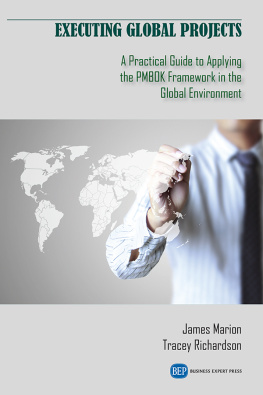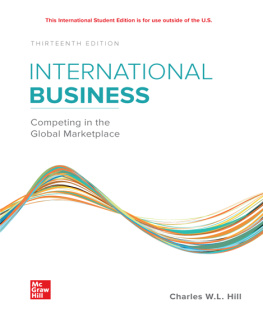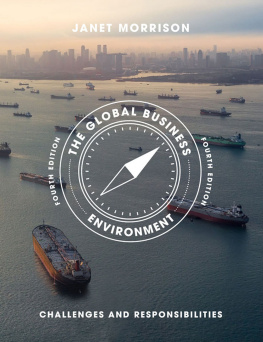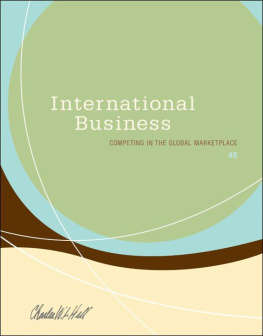Understanding the Global Market
Understanding the Global Market
Navigating the International Business Environment
Bruce D. Keillor

Copyright 2013 by ABC-CLIO, LLC
All rights reserved. No part of this publication may be reproduced, stored in a retrieval system, or transmitted, in any form or by any means, electronic, mechanical, photocopying, recording, or otherwise, except for the inclusion of brief quotations in a review, without prior permission in writing from the publisher.
Library of Congress Cataloging-in-Publication Data
Keillor, Bruce David.
Understanding the global market : navigating the international business environment / Bruce D. Keillor.
p. cm.
Includes bibliographical references and index.
ISBN 978-1-4408-0301-7 (hardcover : alk. paper) ISBN 978-1-4408-0302-4 (ebook)
1. International economic relations. 2. International trade. 3. International business
enterprises. I. Title.
HF1359.K417 2013
658.049dc23 2012037235
ISBN: 978-1-4408-0301-7
EISBN: 978-1-4408-0302-4
17 16 15 14 13 1 2 3 4 5
This book is also available on the World Wide Web as an eBook.
Visit www.abc-clio.com for details.
Praeger
An Imprint of ABC-CLIO, LLC
ABC-CLIO, LLC
130 Cremona Drive, P.O. Box 1911
Santa Barbara, California 93116-1911
This book is printed on acid-free paper
Manufactured in the United States of America
To Gretchen, Jonathan, and Jeremy,
three of the best writers I know
Contents
Preface
Unlike many other books dealing with international business, this is not a how-to approach for developing a successful strategy. Instead, this book specifically addresses what many others often treat in a less than comprehensive mannerthat is, the various facets of the international business environment. The overall purpose of Understanding the Global Market is to provide a practitioner-oriented, easily understood guide to this complex, multilayered international business environment. It differs from other books currently on the market in two ways: first, this is a comprehensive approach to dealing with all aspects of the international business environment, not just the more recognizable, such as culture. Second, in this book, we focus on the unique characteristics of international markets and their effect on international operations, as opposed to a firms attitude toward its operating position in international markets.
In the first chapter, I begin first not by exploring the international business environment but by coming to grips with the various objectives any given firm might seek to achieve in its international operations. The premise is simple: it is impossible to accurately assess any markets environment when the firm has no clear idea what it is trying to accomplish in that market. Along the way, we will also consider why being international may not be an option, as well as the unique challenges that firms face when operating outside of their domestic market. In subsequent chapters, we investigate the cultural environment and how best to connect with customers and employees, the physical environment and how to choose and enter a market, the economic environment and its impact on market attractiveness, the political environment and how the rules for doing business are created, and the competitive environment and how to succeed over time. We then move to how a firm might have an impact on the market in which it operatesand how to manage that impactand some important aspects of the future international environment. The book concludes with a framework for systematically analyzing the international business environment.
Understanding the Global Market is for firms and managers of all types, ranging from those contemplating a move into the global market to those seeking to improve their international operations. By using a combination of established conceptual frameworks, practical perspectives of analysis and assessment, and real-world examples, this book provides a cutting-edge approach to dealing with the various complex challenges firms face when going international. It is absolutely vital for any business involved in international markets to systematically analyze all pieces of its market environment, and this book provides the means for accomplishing this goal. Best of luck in all your international efforts, and enjoy Understanding the Global Market!
CHAPTER ONE
The International Business Environment: An Overview and New Perspectives (Complexities and Choices)
Introduction
Because of the ever-increasing interdependence of markets around the globe, there is a real need for businesses of all sizesand in all countriesto consider the opportunities expanding into this global marketplace might represent. Although large multinationals may get the most attention in the media, the truth is that for virtually any size firm, developing and implementing a sustained growth strategy requires serious consideration be given to moving beyond domestic market boundaries. For a number of reasons, not the least being the internationalization of the marketplace, reliance on a single domestic market is no longer a sustainable long-term business model for the majority of firms. The limited growth opportunities afforded in a single market, coupled with the fact that firms from outside that domestic market are now actively competing for this limited market share, means that small, medium, and large firms must acknowledge the expansion of their operational scope.
Unfortunately, successful international operations demand more than simply expanding a firms current domestic business modelno matter how successful that model may be, or may have been in the past. The primary key to international success is having a clear understanding of the complex nature of the international business environment. Too often, firms will overlook the knowledge they possess when it comes to operations in their own home market. Having a clear perspective when it comes to elements such as consumer tastes, preferences, and overall behavior as well as product pricing, distribution, and competitive dynamics is crucial for sustaining any business but these pieces of the business environment are frequently second nature when it comes to the firms domestic market. This is hardly surprisingan established firm must have a clear handle on all of these elements of the environment (and more) to be established.
However, when these same firms move into new (i.e., international) markets, it is not unusual for them to overlook the need to gain the same level of understanding of all aspects of the environment in this new market. This means carefully considering not only the components of the business environment, but also the various ways in which these could possibly interact, how those interactions may differ from the domestic market, and the impact this will have on current business models and their viability.
Too often any discussion of the international business environment becomes overly focused on cultural differences. Clearly, cultural differences can have a profound effect on the types of products that might appeal to consumers in another market, how those products are used, where they will look for those products, and how to best connect with those consumers. But concentrating too heavily on just cultural differences can result in an incomplete view of an international market for two basic reasons.













